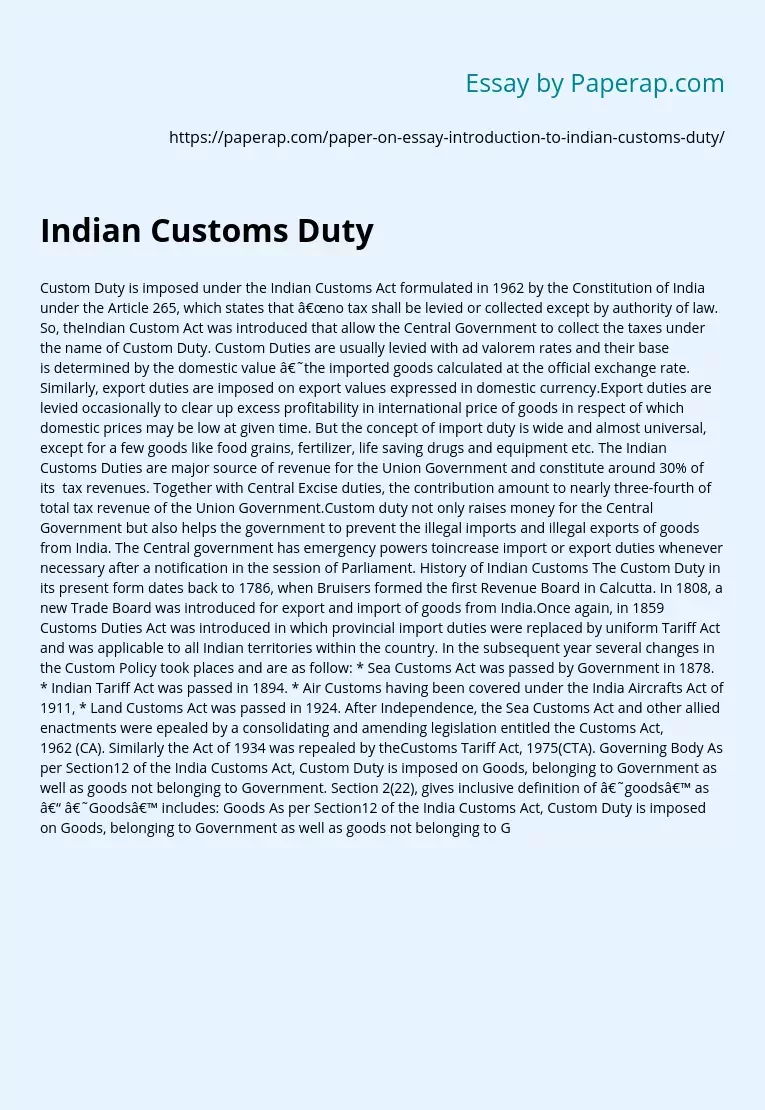Indian Customs Duty
Custom Duty is imposed under the Indian Customs Act formulated in 1962 by the Constitution of India under the Article 265, which states that “no tax shall be levied or collected except by authority of law. So, theIndian Custom Act was introduced that allow the Central Government to collect the taxes under the name of Custom Duty. Custom Duties are usually levied with ad valorem rates and their base is determined by the domestic value ‘the imported goods calculated at the official exchange rate.
Similarly, export duties are imposed on export values expressed in domestic currency.Export duties are levied occasionally to clear up excess profitability in international price of goods in respect of which domestic prices may be low at given time. But the concept of import duty is wide and almost universal, except for a few goods like food grains, fertilizer, life saving drugs and equipment etc.
The Indian Customs Duties are major source of revenue for the Union Government and constitute around 30% of its tax revenues. Together with Central Excise duties, the contribution amount to nearly three-fourth of total tax revenue of the Union Government.Custom duty not only raises money for the Central Government but also helps the government to prevent the illegal imports and illegal exports of goods from India. The Central government has emergency powers toincrease import or export duties whenever necessary after a notification in the session of Parliament.
History of Indian Customs The Custom Duty in its present form dates back to 1786, when Bruisers formed the first Revenue Board in Calcutta. In 1808, a new Trade Board was introduced for export and import of goods from India.Once again, in 1859 Customs Duties Act was introduced in which provincial import duties were replaced by uniform Tariff Act and was applicable to all Indian territories within the country. In the subsequent year several changes in the Custom Policy took places and are as follow: * Sea Customs Act was passed by Government in 1878. * Indian Tariff Act was passed in 1894. * Air Customs having been covered under the India Aircrafts Act of 1911, * Land Customs Act was passed in 1924. After Independence, the Sea Customs Act and other allied enactments were epealed by a consolidating and amending legislation entitled the Customs Act, 1962 (CA). Similarly the Act of 1934 was repealed by theCustoms Tariff Act, 1975(CTA). Governing Body As per Section12 of the India Customs Act, Custom Duty is imposed on Goods, belonging to Government as well as goods not belonging to Government. Section 2(22), gives inclusive definition of ‘goods’ as – ‘Goods’ includes: Goods As per Section12 of the India Customs Act, Custom Duty is imposed on Goods, belonging to Government as well as goods not belonging to Government.Section 2(22), gives inclusive definition of ‘goods’ as – ‘Goods’ includes: * Vessels, aircrafts and vehicles * Stores * Baggage * Currency and negotiable instruments and * Any other kind of movable property. Objectives of Custom Duties The customs duty is levied, primarily, for the following purpose: * Restricting Imports for conserving foreign exchange. * Protecting Indian Industry from undue competition. * Prohibiting imports and exports of goods for achieving the policy objectives of the Government. Regulating export. * Co-coordinating legal provisions with other laws dealing with foreign exchange such as Foreign Trade Act,Foreign Exchange Regulation Act, Conservation of Foreign Exchange and Prevention of Smuggling Act,etc. Mode of Levy of Customs Duty Basically there are three modes of imposing Customs Duty: 1. Specific Duties: – Specific custom duty is a duty imposed on each and every unit of a commodity imported or exported. For example, Rs. 5 on each meter of cloth imported or Rs. 500 on each T.V. set imported. In this case, the value of commodity is not taken into consideration. 2. Advalorem Duties: Advalorem custom duty is a duty imposed on the total value of a commodity imported or exported. For example, 5% of F. O. B. value of cloth imported or 10% of C. LF. value of T. V. sets imported. In case of Advalorem custom duty, the physical units of commodity are not taken into consideration. 3. Compound Duties: – Compound custom duty is the combination of specific and advalorem custom duties.In this case, the quantities as well as the value of the commodity are taken into consideration while computing tariff. For example, 5% of F. O. B. value plus, 50 paisa per meter of cloth imported. Decline in Customs Duty India’s customs tariff rates have been declining since 1991. The “peak” rate has come down from 150% in 1991-2 to 40% in 1997-98. The downward momentum was reversed the next year with the imposition of a surcharge. This momentum has resumed with the reduction of the “peak” rate to 35% in 2001-2 and 30% in 2002-3
Indian Customs Duty. (2019, Dec 05). Retrieved from https://paperap.com/paper-on-essay-introduction-to-indian-customs-duty/

